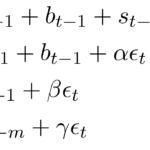This year, I couldn’t attend the International Symposium on Forecasting (organised by the International Institute of Forecasters), which I usually do, so instead I went to Gran Canaria for the International Conference on Time Series and Forecasting (aka ITISE). The location was fantastic, and I enjoyed several talks. I was also glad to catch up […]
ITISE2025: Beyond summary performance metrics for forecast selection and combination






